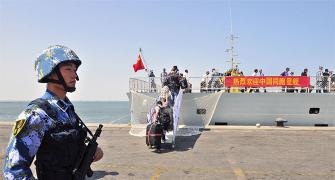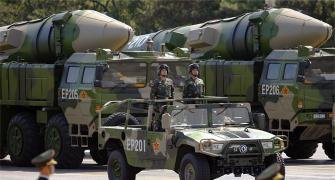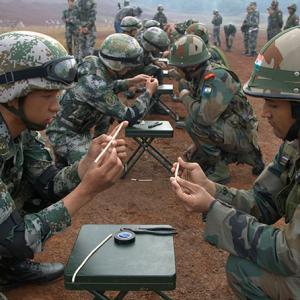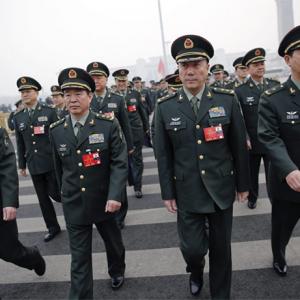Since 55 per cent of Indian trade passes through the South China Sea, and with over $5 billion investments in the energy sector in Vietnam, it is imperative for India to actively pursue its national interests in the region, argues Srikanth Kondapalli.
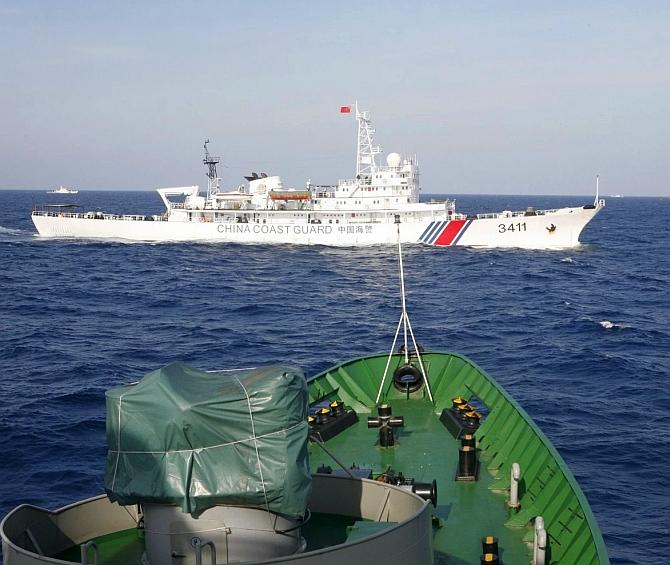
The military balance of power is increasingly shifting towards China even though several nations have contested its claims in the region.
China is making its own preparations for militarization of the region, despite undertakings by President Xi Jinping during his visit to the United States recently.
In February 2016, according to satellite images, China deployed two batteries of 8 HQ-9 surface to air missile launchers on Woody (Yongxing) Island in the Paracels to impose its anti-access area denial strategy in the region.
China's maritime Silk Road idea is thus quickly acquiring teeth.
Dramatic events are unfolding in the region.
The United States sent the USS Lassen and the USS Curtis Wilbur in October 2015 and January 2016 respectively closer to the reefs constructed by China in the Spratlys and conducted freedom of navigation operations.
Taiwan's President Ma Ying-jeau visited Taiping Island in January 2016 to show that his country's position matters in the dispute.
Vice-President Hamid Ansari recently signed a defence cooperation agreement with Brunei, a contestant.
Xi Jinping, as chairman of the emergency relief mechanisms at the highest Politburo level of the Chinese Communist Party, had personally given orders for the construction activity in several reefs.
China has been following the 'quadrilateral fortress' strategy in the region of connecting the Paracels, the Spratlys, the Macclesfield Bank-Scarborough Shoals through a series of strategic, naval, air and support military measures of dominating the region.
China's military preparations in the region are comprehensive in nature and dramatic recently.
First, China began deploying over 3,000 km range solid propellant 'Guam-killer' DF-26 anti-ship ballistic missiles. Also, the Type 094 Jin-Class strategic nuclear submarine made maritime patrols at the end of 2015 in the western Pacific.
Second, by December 12, 2015 China deployed its latest third 052D missile destroyer the 'Hefei destroyer' (earlier the 'Kunming destroyer', and the 'Changsha destroyer') in the South China Sea for both air and submarine defence missions.
At the same time, China unveiled its largest coastal ship the GY820 at Sansha in Hainan that carry tanks, helicopters and other military equipment for support missions in the combat region.
Third, China is expanding its air cover through the air traffic control in the region with airfields and aircraft deployments.
China's runways in the region are long enough to accommodate H-6K bombers, including the 2,400 metre-long runway on the Woody (Yongxing) Island, building 3,000 metre runway on the Yongshu Reef, and another on the Subi Reef.
In November 2015, China sent eight H-6K bombers. Also, the recently signed deal with Russia on 24 Su-35 fighters could be deployed to the region.
Fourth, China is building up support facilities for long haul missions. China has also built port and shipping facilities, desalination, sewage and garbage treatment stations, hospitals, schools etc to reinforce its sovereignty claims.
The presence of large-scale fuel storage on the artificial islands suggests building of active air bases by China. China is also planning to setup a 'stopover point' at the Kota Kinabalu port in Sabah, Malaysia.
China's militarisation of the South China Sea has regional and international security ramifications given the 29 sea lanes of communications passing through the region, trillions of dollars of trade passage, potential energy or fishery resources.
China suggested initially that its efforts are peaceful in nature, but exhibited military control, thus jeopardising regional peace.
The US argued for freedom of navigation and made preparations with the regional powers, but thus far has not been effective.
The Japanese on their part have included the Philippines in the recently enacted 'collective self-defence' partnership and have also agreed to sell fast attack craft to Manila.
All the above suggest China's emergence and its military control over the region.
Since 55 per cent of Indian trade passes through this region, and with over $5 billion investments in the energy sector in Vietnam, it is imperative for India to actively pursue its national interests in the region.
During the Chola period, vast tracts of Southeast Asia came under India's influence. While jettisoning the 'historical claims,' independent India began a new engagement policy towards the region.
On the other hand, China gradually occupied the region since 1974 through military means even as it professed peaceful rhetoric.
India had recently graduated from 'Look East' to 'Act East' although no major moves were made so far.
India had stated that the sovereignty issues be resolved through bilateral and peaceful means and insisted on uninterrupted flow of trade after the INS Airavat incident in 2009. None of these convinced Beijing.
India needs to change its course in the region with a pro-active policy of winning friends and allies, evolving maritime understanding with likeminded stake-holders, exploring naval support facilities and establishing mutually beneficial long-term institutional commitments.
Srikanth Kondapalli is Professor in Chinese Studies at Jawaharlal Nehru University.


